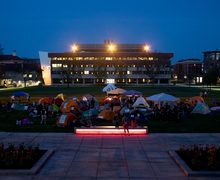A $300 million school investment can increase opportunities for students
Daily Orange File Photo
The United States is riddled with low-performing schools.
Investing in and improving public education in the United States could hardly be more popular. Presidents from Lyndon Johnson to Obama touted their goals of serving as “the education president” despite the wide variation in their policy stances and partisan alignments.
In a nation that values hard work and determination, it’s difficult to stomach an education system where students born into privilege so blatantly benefit from academic advantages, regardless of talent or effort. Syracuse Mayor Ben Walsh announced in September that the city will invest $300 million in its public school system. The investment provides the city, struggling with poverty and violence, with the opportunity to level the academic playing field in an increasingly unequal nation.
The ongoing project focuses on renovating the facilities of Syracuse’s public schools. Prior to the renovation, several schools were lacking the physical resources necessary to best teach the curriculum. Bellevue Elementary School had no walls, and students struggled to remain focused in a school where you could hear the lesson being taught the next class over just as well as the one right in front of you. Some extracurricular activities couldn’t find the necessary space or equipment for their projects.
Students perform considerably lower at schools with poor infrastructure and facilities across the board, and even talented students fail to thrive when their school’s resources insufficiently nurture them.
Suzanne Slack, the district’s Chief Financial Officer, said updates could improve the student experience.
“Our science labs need to be aligned with today’s science curriculum, our art and music rooms have to be the right size and configuration to accommodate kilns, sinks, musical instruments for kids to succeed,” Slack said in an email.

Karleigh Merritt-Henry | Digital Design Editor
Even with talented teachers and students, a school can only teach the lessons it is physically equipped to offer. While some schools across the nation have consistent access to the latest educational resources, most don’t, and no amount of raw intellect or passion can make up for that.
While failing schools have an adverse impact on students, the inverse is true as well. When students see their school improving, they see the government demonstrating its belief in them. They see a community telling them that they are worthy of the best facilities and opportunities available. It’s a powerful message, especially in a district like Syracuse’s where several schools have been ranked among the lowest performers in the state.
“All children deserve an inspiring school environment and we are doing our best to provide that with our facility renovations,” Slack said. “People hold their school building memories for a lifetime. You find this out when a school closes or is repurposed because folks of all ages come out to talk about the bricks and mortar of their childhood and beg to keep it as is.”
The United States is riddled with low-performing schools. Some schools in California have no air conditioning. Some schools in Philadelphia have no heat and struggle with asbestos exposure and rodent infestations. In Detroit, the drinking water in schools was cut off because of possible lead and copper exposure. Many of these districts have received press coverage and attention from lawmakers and local officials.

Karleigh Merritt-Henry | Digital Design Editor
But merely naming an issue isn’t enough. Talking about improving education doesn’t actually improve education. State of the art facilities, new books and well-paid teachers improve education, and well-educated students improve cities.
Good schools mean better value for homes. They mean talented students aren’t hesitant to start families in their childhood neighborhoods. A considerable number of societal problems find their roots in a weak education.
$300 million is a lot of money. It’s a difficult figure for most Americans to even conceptualize. Asking tax-payers to subsidize any project with a price tag that high is, understandably, a hard sell, especially when some districts’ increased funding has failed to improve school quality.
But the nature of these renovations emphasizes the 21st century classroom in a way that projects shepherded by other districts across the nation has not. Great teachers and strong curriculum are crucial ingredients to school success, but so is the physical school. By investing in comfortable, useful and welcoming facilities, the Syracuse school district has the potential to transform the district into an inviting place for its students — somewhere they can access the opportunities all students deserve.
Sydney Gold is a freshman policy studies and public relations major. Her column appears bi-weekly. She can be reached at segold@syr.edu. She can be followed on Twitter @Sydney_Eden.
Published on November 5, 2019 at 11:32 pm




